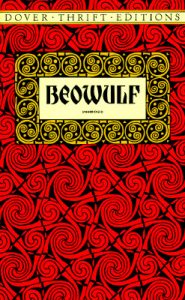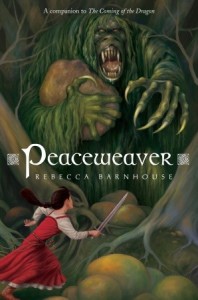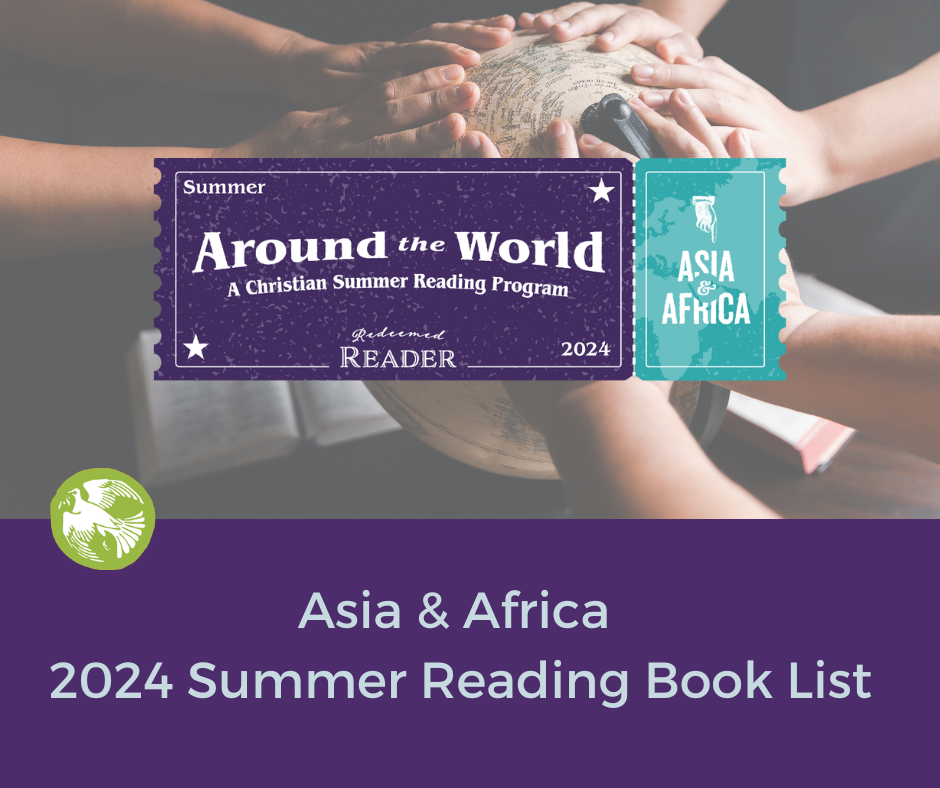When I used to teach high school British Literature back in the day, Beowulf was always our first big study. It’s first chronologically, and it’s also an outstanding way to introduce worldview-in-literature concepts. As the school year gets underway, I thought I’d share a bit of my approach to Beowulf in particular and literature in general, highlighting some of the worldview study we did.
Beowulf: Legend
Beowulf is a classic legend: high drama (I mean, c’mon: Grendel’s arm gets pulled OFF in the very first book), terrific heroes (Beowulf himself is definitely larger than life), good v. evil (again, the very first book pits good guys v. evil monster). This is the real deal. So why does everyone issue a collective groan when this title is mentioned? Why is it such a hard study?
1. We force kids to read a hard text. Beowulf wasn’t originally meant to be read. It was an oral tale, passed down from skilled storyteller to skilled storyteller. If you’ve ever heard a professional storyteller work their magic, you’ll quickly realize why Beowulf would be far more entertaining in that form than in some hard-to-read poetic format. In fact, listen to some of Beowulf in Old English–your Lord of the Rings fans will no doubt note the similarities between Old English and some of Tolkien’s languages.
2. We don’t let kids enjoy the legend. We get hung up on the format of Anglo-Saxon poetry (I know I felt like I had to teach this part). We focus on how different oral storytelling is from written texts in an academic sense (even though we’re reading that oral story).
Try hooking kids on the story (see below for some great contemporary texts to play around with). Try telling the legend first, even if you’re not a professional storyteller. Just tell the story. Let Beowulf as a hero roll around in the kids’ minds. Let them picture Grendel in all his nastiness. Imagine a man ripping a monster’s arm off….What about acting out Beowulf or having kids make a movie out of it? It will be gory, but it will also feature the heroic. Or go back to one of those links above–professional storytellers working their magic.
Beowulf: Worldview
It’s important for students to enjoy Beowulf as a literary legend, but Beowulf is a also perfect example of pagan culture. And one that’s very transparently pagan. Don’t miss this opportunity! Talk about how life might have been different if their culture’s beliefs had been different. Talk about how their beliefs might have been different in a more modern, industrialized (think: post-Enlightenment) society. How did the Geats explain Grendel? (a monster) Could the sea monster have been an actual animal they didn’t have a name for yet? Could the dragon have been a real animal? How does our culture and time period influence our understanding of the natural world? How does our faith influence our understanding of the natural world? (everything from weather to animal life to global warming)
One of my Covenant College professors, Dr. Lou Voskuil, used what he called a “Culture Box” in his global history course; it’s a great graphic organizer for worldview analysis, and one I used quite successfully with my tenth graders in our study of Beowulf and other literary works. Try it out with your high school students–do a Culture Box for our contemporary American society first, then one for Beowulf’s society. Click on the link below to pull up the printable (directions are on the printable).
Beowulf: Contemporary Texts
If you have time in your studies and/or your son or daughter is really interested in the legend and culture of Beowulf, then I encourage you to check out Rebecca Barnhouse’s young adult novels about Wiglaf. Set just after the more well known events of Books 1-2 from Beowulf (when Grendel and his mother are taken care of), The Coming of the Dragon follows Wiglaf/Rune as a boy, filling in the gaps from Beowulf. Peaceweaver is a companion novel about Wiglaf’s future wife, Hild; both novels end at the same point: when the Wiglaf/Rune and Hild first meet. A third volume comes out later this fall (Ring-Giver) and will carry on their story.
Barnhouse does a fantastic job of creating an authentic Anglo-Saxon setting in these novels. They read like any good fantasy/adventure story complete with dragon and monster, but the depiction of Anglo-Saxon beliefs and customs is woven in marvelously. They provide a perfect complement to what is often a dry study of Beowulf. And, they will help showcase the worldview and culture that lurks in the background of Beowulf and makes it the important story it is.
You can also check out Gareth Hinds’s solid graphic novel retelling of Beowulf. It is definitely gory, but the original legend IS gory. His palette choice is perfect and keeps much of the blood simply a dark color (not bright red). Full of action, this is a good hook for more reluctant readers. Try flipping through this first to whet appetites for a more complete study of Beowulf. Or, watch this YouTube video of Beowulf in three acts–accompanied by much of Hinds’s art.
Beowulf: Worth It!
To sum-up: READ this important work! And ENJOY it! This is often one of the first works to appear this time of year for students. Start off on the right note.
Hayley will be talking about some other graphic novels based on classic texts and how to use them as teaching tools, so check back later for those reviews! And for other great resources on RedeemedReader relating to heroes, classic literature, and the like, see The Hero’s Journey (another great teaching resource that works quite well with Beowulf), Janie’s review of Douglas Bond’s Anglo-Saxon novel The Hand of Vengeance, and Emily’s recent line-up of free Middle Ages audiobooks (including Beowulf!).
Cover images from indiebound.org and goodreads.com
Stay Up to Date!
Get the information you need to make wise choices about books for your children and teens.
Our weekly newsletter includes our latest reviews, related links from around the web, a featured book list, book trivia, and more. We never sell your information. You may unsubscribe at any time.
Support our writers and help keep Redeemed Reader ad-free by joining the Redeemed Reader Fellowship.
Stay Up to Date!
Get the information you need to make wise choices about books for your children and teens.
Our weekly newsletter includes our latest reviews, related links from around the web, a featured book list, book trivia, and more. We never sell your information. You may unsubscribe at any time.
We'd love to hear from you!
Our comments are now limited to our members (both Silver and Golden Key). Members, you just need to log in with your normal log-in credentials!
Not a member yet? You can join the Silver Key ($2.99/month) for a free 2-week trial. Cancel at any time. Find out more about membership here.
10 Comments
Leave a Comment
You must be logged in to post a comment.








Just in time for back to school. Thank you for all the ideas and helps in making this masterpiece more enjoyable for students! While I remember reading it in High School and finding parts very difficult to read – I also remember falling in love with the epic nature of story here. Sometimes we get lost in the details and sacrifice the idea of story. thank you for the reminder
I read a simplified version of this to my 6 and 4 year olds, and they loved it! Great reviews and suggestions, Betsy.
P.S. I have three boys, so they are fascinated by the, um, details. I read them an illustrated retelling by James Rumford that was good. I think Rosemary Sutcliffe has a version, probably available in some libraries.
Thank you for the interesting ideas, Betsy! My high school literature teacher focused on getting the vocabulary down for college and taking book tests on as many books as possible so we would be “well-read.” She never got to the heart of literature, which is where I want to be. In college I was too focused on science, and I missed out there as well. I am learning with them, and I so appreciate these helps along the way!!
This is great, Betsy! Thanks,
A late-90s movie called The 13th Warrior is based on a novel by Michael Creighton, which is in turn based on Beowulf. The R rating is for gore, but I don’t remember it being THAT bloody. Definitely creepy, though. Parents as always should use their judgment, but high-schoolers might enjoy finding the parallels.
For read aloud with early elementary age kids, we enjoy Ian Serrailier’s version. It is short enough to read in one sitting and it is in verse.
I would second the James Rumford illustrated version for Beowulf in a picture book for the younger set.
I will definitely look for Rebecca Barnhouse’s books – thanks for the suggestion!
Are there online audios of Beowulf read in Anglo Saxon? Or audiobooks with both English and Anglo Saxon?
Cathy–one of those links in the first paragraph under Beowulf the Legend has an audio/YouTube version in Anglo-Saxon. I’m sure you can find more. I just did a cursory search and found a LOT of options. It’s amazing what’s available now that wasn’t when I was teaching this!!
I love the other suggestions, too, for simpler reads.
Great post, Betsy! I love Beowulf, but I am often tempted to get caught up in the intricacies of Anglo-Saxon verse instead of focusing on the story. Rosemary Sutcliff’s version of Beowulf is a wonderful read-aloud and though prose, it has a flow and rhythm that is beautiful when read. It’s a definitely hark back to Beowulf’s original storytelling roots.
Thank you for this timely assist! We will be tackling Beowulf this year (AO/HUFI Year 7) and I say “we” because my high school/college education did not include it, so the daughter and I will be learning together. 🙂
Sara–hope you enjoy it! It’s a great story.